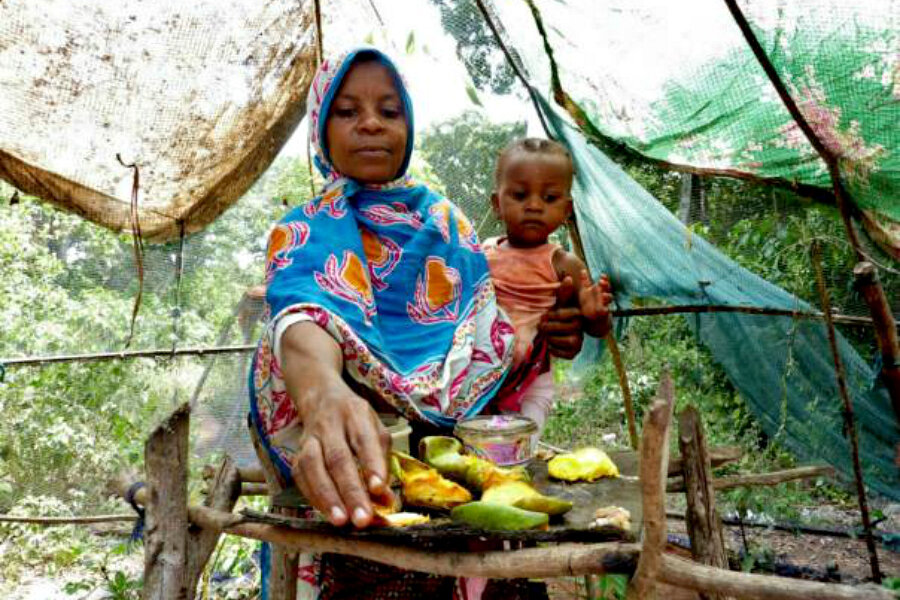To save a rare forest, farmers try a new crop – butterflies
Loading...
| PETE, Tanzania
The colorful butterflies fluttering through Zanzibar's Jozani forest are beautiful to look at, but for farmers and charcoal producers in the region, they mean something more: a paycheck.
In an effort to protect the island's threatened forest, local people are being trained to rear butterflies, under a scheme that tries to prevent deforestation by giving people a financial stake in keeping the forest intact.
Jozani forest, which lies between the mangrove-filled bays of Chwaka and Uzi on Unguja Island, is a large mature woodlands that is home to an array of endangered species, including the colorful Red colobus monkey.
But for all its beauty, the forest is under huge pressure from rapid deforestation due to charcoal production and unsustainable farming.
A community-run initiative, the Zanzibar Butterfly Center, aims to change that by retraining charcoal producers in villages surrounding the forest as butterfly farmers.
"We cannot stop anyone from producing charcoal. However, we try to educate people about the damaging effects it has on the environment," Natalie Tempel-Merzougui, the project's facilitator, told the Thomson Reuters Foundation.
The program offers training and equipment to butterfly farmers, the most successful of whom can earn as much as $250 a month selling butterfly pupae to the center's own tourist exhibit and to overseas buyers, she said.
Butterfly farmers operate by catching a few female butterflies and transferring them to mesh cages so they can lay eggs. Farmers then collect the eggs and raise the caterpillars by feeding them on host plants until they turn to pupae.
It's at this stage that farmers start earning by selling the pupae to the butterfly center, which sells them for export or keeps them until they hatch, to display for tourists.
Established in 2008, the center, located near to Jozani Chawka Bay National Park, is one of Africa's largest butterfly exhibits, housing more than 50 species of native butterflies, including the hard-to-catch flying handkerchief, a black and white African swallowtail.
The center, which works closely with Jozani Environmental Conservation Association, draws tourists interested in seeing and learning about butterfly species.
"The aim is to create awareness on the importance of protecting forests and also to give local residents additional income," Merzoughui said.
Rungu Hamisi, one of the butterfly farmers who used to earn a living making charcoal, said raising butterflies has improved his income remarkably.
"Butterfly rearing is much easier than charcoal making, which requires a lot of work. I get enough money to support my family," he said.
He said one of the benefits of farming butterflies, rather than crops, is that they mature quickly.
"Once the eggs hatch and become caterpillars, it takes only a matter of weeks before they transform into butterflies ready for sale," he said.
According to butterfly center officials, the project has also created opportunity for women since butterfly rearing can fit easily around domestic chores.
"I get enough money to feed my children without necessarily destroying forests," said Mwamvua Ali, 49, who said she likes raising the "flying handkerchief" as it lays lots of eggs.
While many types of agriculture require the clearing of forest, which can drive climate change and the loss of species, butterfly farming requires intact forest which provides an economic incentive to conserve them, Merzoughui said.
Alfred George, the assistant manager of the butterfly center, said that through the project many farmers at Pete village have realized the importance of conserving forests, and some are already reaping better returns from butterfly rearing.
"A lot of trees are being cut to provide firewood for local communities who rely on charcoal as their sole source of energy," George told the Thomson Reuters Foundation.
But "most of the farmers we have trained to rear butterflies no longer cut down trees," he said.
Safina Omar who began producing charcoal after she was banned from farming near the Jozani forest, said butterfly farming has given her a workable alternative.
"I knew charcoal trade is bad for environment but I was doing it because I couldn't immediately think of any other way to make money, yet I had many children to take care of," she said.
Although the initiative is not in itself a solution for deforestation, it has helped create awareness and a sense of ownership of the forest among the farmers, George said.
A similar project is run by 250 local farmers in Tanzania's East Usambara Mountains, a region known for its biodiversity but where forests are being cleared to produce charcoal and to open up farmland.
According to the Zanzibar Butterfly Center, the amount each farmer earns varies depending on how many pupae they bring to the center and of what species.
"We pay more for species that are rarer and harder to farm. We see some of our top farmers earn up to 500,000 Tanzanian shillings [$250] per month," Merzoughui said.
Charcoal and firewood comprise about 90 percent of energy used for cooking in Tanzania, according to the World Bank.
The government estimates between 130,000 and 500,000 hectares (500 to 1,930 square miles) of forests are destroyed each year as a result of charcoal production, poor farming, and overgrazing.
• Reporting by Kizito Makoye; editing by Laurie Goering. This story original appeared on the website of the Thomson Reuters Foundation, the charitable arm of Thomson Reuters that covers humanitarian news, climate change, women's rights, trafficking, and corruption. Visit www.trust.org/climate.







